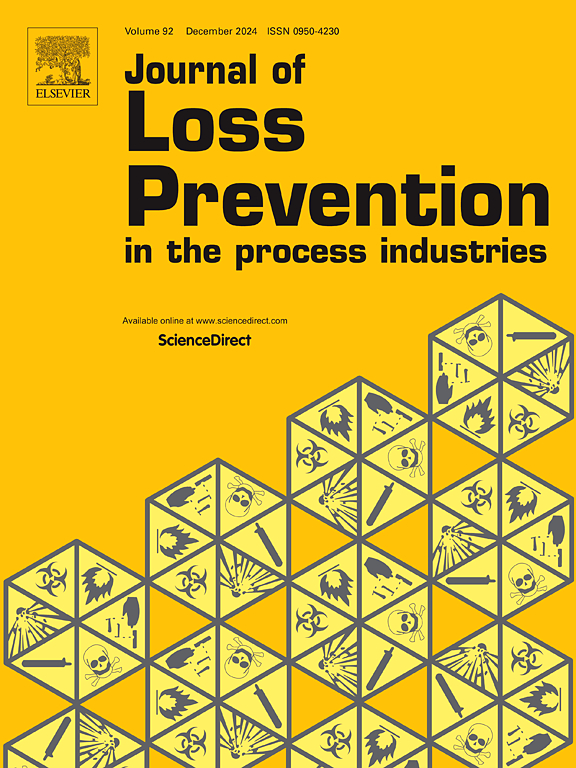选定工业粉尘在大型试验中爆燃的实验研究
IF 3.6
3区 工程技术
Q2 ENGINEERING, CHEMICAL
Journal of Loss Prevention in The Process Industries
Pub Date : 2025-02-18
DOI:10.1016/j.jlp.2025.105592
引用次数: 0
摘要
本文对选定的工业粉尘的爆燃特性进行了大规模试验研究。这项研究的目的是评估工业环境中常见的各种粉尘样品的点火和爆炸行为,如金属、煤炭和有机粉尘。大规模试验是在受控环境下进行的,使用标准爆炸室,特别是在石灰石地块上加盖的实验坑道,并配备了压力传感器和火焰监测装置。通过对压力升和火焰传播速度等关键参数的测试,了解粉尘的爆燃特性。下面提到的材料,在生产工业操作中以粉末形式存在,要么作为成品,要么作为一层沉淀的灰尘,依次进行测试。试验的目的是确定所选材料在以一维传播为主的密闭空间中的爆炸参数。具体而言,研究的参数为爆炸下限、最大火焰前范围、最大火焰前速度和最大压力波速度。所测试的材料是在某些类型的工业操作中发现的。这主要是能源、食品工业、金属加工业、木材工业或农业领域。以褐煤、面粉、铝粉和木屑为样品。测定了所有物质的爆炸参数。从防止粉尘爆炸和粉尘爆炸性研究的角度来看,这些实验突出了不同的环境、几何形状和可燃系统(混合物)如何引起不同的表现,并由此对周围环境造成不同的后果。这些发现有助于更好地了解工业环境中的粉尘爆炸风险,强调了定制安全措施和粉尘控制策略以减轻危害的重要性。该研究为改进处理可燃性粉尘的工业防爆和保护系统提供了有价值的见解。本文章由计算机程序翻译,如有差异,请以英文原文为准。
Experimental investigation of deflagration of selected industrial dusts during large-scale tests
This study presents an experimental investigation of the deflagration characteristics of selected industrial dusts during large-scale testing. The aim of the research was to assess the ignition and explosion behaviours of various dust samples commonly encountered in industrial environments, such as metal, coal, and organic dusts. Large-scale tests were conducted in a controlled environment using a standard explosion chamber and in particular experimental adits stamped in the limestone massif equipped by pressure sensors and flame monitoring devices. The tests focused on key parameters, including pressure rise and flame propagation velocity to understand the deflagration properties of the dusts.
The materials mentioned below, which are found in powder form in production industrial operations, either as a finished product or as a layer of settled dust, were tested in turn. The tests were aimed at determining the explosion parameters of the selected materials in a confined space with predominantly 1D propagation. Specifically, the parameters studied were the lower explosive limit, the maximum flame front range, the maximum flame front velocity and the maximum pressure wave velocity. The materials that were tested are found in certain types of industrial operations. This is mainly the field of energy, food industry, metal processing industry, wood industry or agriculture. Brown coal, flour, aluminium dust and wood dust were used as samples. Explosion parameters were determined for all substances.
The experiments have highlighted how, from the point of view of dust explosion prevention and the study of dust explosiveness, different environments, geometries and combustible systems (mixtures) cause different manifestations and, with that, consequences on the surroundings. The findings contribute to a better understanding of dust explosion risks in industrial settings, highlighting the importance of tailored safety measures and dust control strategies to mitigate hazards. This study provides valuable insights for improving explosion prevention and protection systems in industries handling combustible dusts.
求助全文
通过发布文献求助,成功后即可免费获取论文全文。
去求助
来源期刊
CiteScore
7.20
自引率
14.30%
发文量
226
审稿时长
52 days
期刊介绍:
The broad scope of the journal is process safety. Process safety is defined as the prevention and mitigation of process-related injuries and damage arising from process incidents involving fire, explosion and toxic release. Such undesired events occur in the process industries during the use, storage, manufacture, handling, and transportation of highly hazardous chemicals.

 求助内容:
求助内容: 应助结果提醒方式:
应助结果提醒方式:


